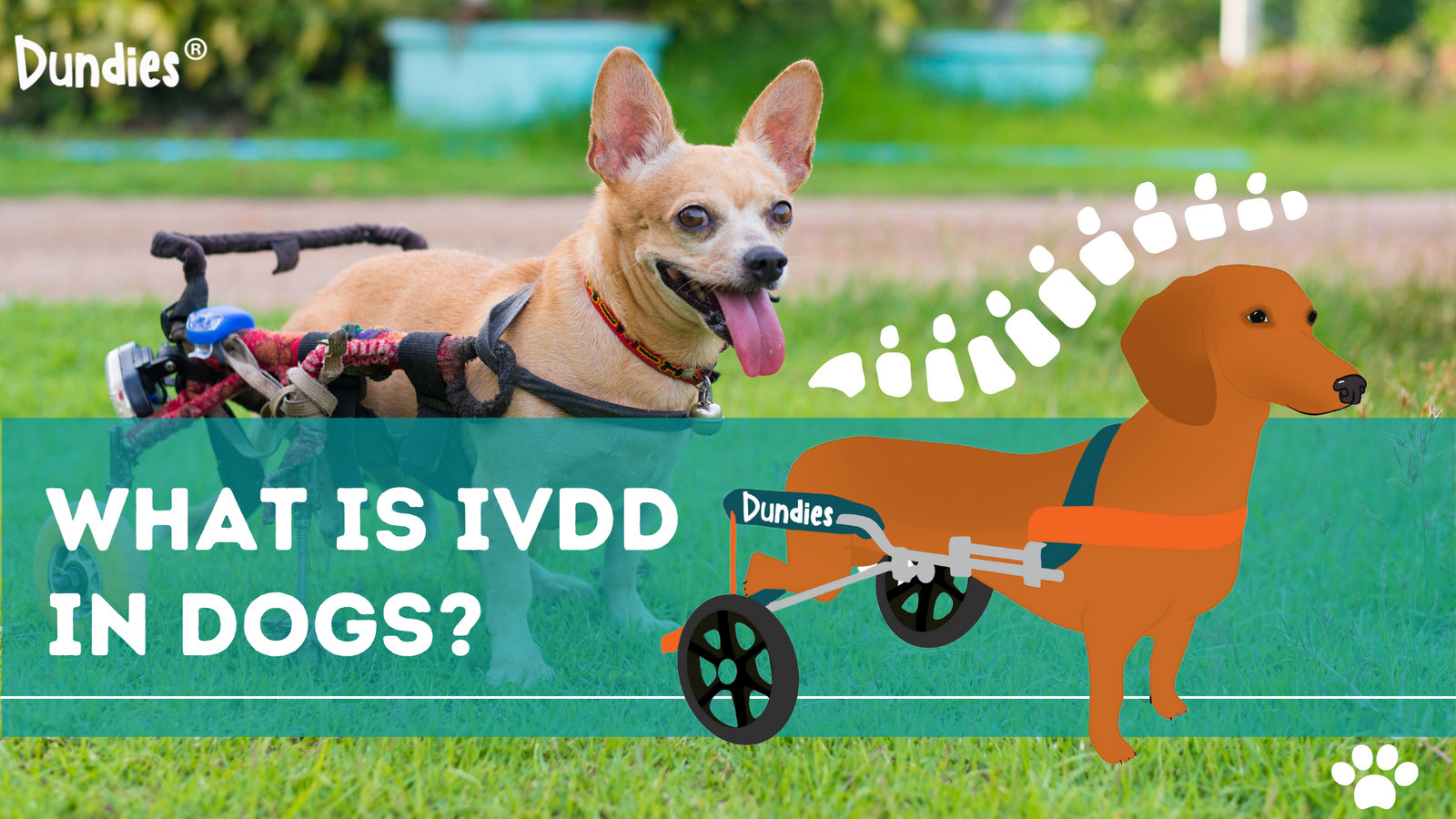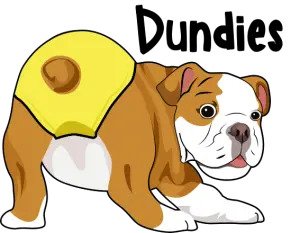
Maybe you have heard of a dog having a ruptured disk, a slipped disk or a herniated disk in their back. Intervertebral disk disease often referred to as IVDD and is a degenerative disease that can affect your dog’s spinal cord. IVDD is a very common condition seen in thousands of dogs every year, it is also very serious. This condition can cause a variety of different concerns for your dog from mobility to incontinence and pain. Most commonly seen in Dachshunds and other small and medium breeds, IVDD can be treated and managed depending on the severity of the condition with both surgical and non-surgical interventions. In this blog we will cover everything you need to know about IVDD.
What is IVDD in dogs?
IVDD, or Intervertebral Disc Disease is a spinal disease that occurs in dogs. It happens after a disk in your dog’s spine herniates causing damage. In between each of the pieces of your dog’s spine, their vertebrae, is a jelly like substance called a disk, these disks help to protect the spinal cord and act as a shock absorbing protective barrier. When a disk in your dog’s back slips, it can cause a compression of the spinal cord which causes lasting and debilitating damage. While a disk can herniate anywhere along your dog’s spine, 65% occur in the mid back (lumbar) area and 18% occur in the neck region.

What Causes IVDD in Dogs and the types of IVDD?
-
IVDD is Genetic & hereditary
-
Forceful Jumping
-
Falling and bad landing
-
Gradual hardening of the jelly disks between the vertebrae
-
Risk factor if your dog is overweight
IVDD in dog’s is a known hereditary condition so if you are buying a new puppy from a breeder, make sure to ask about any history of disk diseases from the parents or grandparents of your puppy.
Vet scientists from the Department of Surgical and Radiological Studies at the School of Veterinary Medicine, University of California, have been investigating the link between premature IVDD and the FGF4 gene. Initial studies are showing that an overexpression of this gene is a major disease factor in IVDD but we still need more research to further understand this complex disease.
It’s important to note that there are two types of IVDD, Hansen Type I and Hansen Type II.
Hansen Type I is a sudden rupture of a disk, and is more frequently seen in dachshund and corgis. This type of IVDD occurs suddenly usually from an impact like our dog jumping off a couch and landing really hard on the floor. It can result in pain, difficulty walking, inability to urinate and sometimes paralysis.
Hansen Type II is a slower more gradual progression of the spine's degeneration. It’s more frequently seen in larger breeds like Labradors & German Shepherds. With this type of IVDD the disks in the spine become hardened over time, eventually rupturing and it’s not often linked to any particular movement or impact.
Signs and Symptoms of IVDD in Dogs
Knowing what to look out for means you can act fast and take your dog to the vet right away if you think they may have IVDD. Early intervention is paramount to minimise the risk of permanent damage. Keep an eye out for the following symptoms:
-
Lowered head stance
-
Aggression and yelping when you touch them
-
Reduced activity level or lethargy
-
Knuckling, dragging their back feet or limb paralysis
-
Loss of bladder control
-
Loss of bowel control
-
Not passing any urine and getting a swollen bladder
-
Trembling and panting
-
Not eating
-
Arching or curling of the back
-
Stiffness in the neck, limbs and back
-
Obvious pain
-
Back muscle spasms and
-
Difficulty walking or not walking as normal
Your dog’s IVDD symptoms and the severity of their symptoms can be just as unique as they are. Every dog who has a slipped disk won’t become paralysed, they may show difficulty walking on one or more of their legs depending on the severity of IVDD they have and how their spinal cord has been affected.

What Dog Breeds at Risk of IVDD?
It is estimated that between 45 and 70% of all IVDD cases occur in dachshunds, so if you are a dachshund owner you should be aware of the signs to look out for just in case your dog suffers with IVDD.
Most common breeds affected by IVDD are:
-
Dachshund – Hansen Type I
-
Shih Tzu – Hansen Type I
-
Beagle – Hansen Type I
-
Poodle – Hansen Type I
-
French bulldog – Hansen Type I
-
Pekingese – Hansen Type I
-
Corgi – Hansen Type I
-
Basset hound – Hansen Type I
-
Chihuahua – Hansen Type I
-
Labrador retriever – Hansen Type II
-
Doberman pinscher – Hansen Type II
-
German shepherd - Hansen Type II

How is IVDD in Dogs Diagnosed?
I think my dog has IVDD, what next? If you think you dog may have IVDD and they are displaying the signs and symptoms of a slipped disk, it’s time to head to the vet straight away. Your vet will then perform an initial assessment and determine if they need to send you to a specialist or if they can manage and treat in clinic.
X-ray, CT or MRI scans can be used to take images of your dog’s spine to diagnose a disc herniation / slipped disk.
Your vet or specialist will determine the best type of imaging needed to properly assess your dog and work out where the spinal injury has occurred. The vet will also conduct a neurological exam.
If the examination shows that your dog has a mild to moderate spinal injury, treatment may include administering steroids or anti-inflammatory medication to reduce swelling and pain. In more severe cases, surgery may be required.

5 Stages of IVDD
IVDD severity is broken down into 5 stages, a vet will assess and grade the stage of IVDD your dog is experiencing. Knowing the grade of severity can help you make the best-informed decision towards treating your dog’s condition.
At stage 1 and 2, non-surgical treatment can be considered first. You can look at surgery in the future if your dog does not improve with treatments. For stage 2 to 5, surgery will provide a better chance at a positive outcome for your dog.
Stage 1 – Mild pain, no neurological concerns. Resolution with non-surgical treatment happens in most cases.
Stage 2 – Moderate to severe pain. Walking but with knuckling or poor coordination. Non-surgical treatment resolves around 50% of cases.
Stage 3– Can’t walk but can still move back legs. Non-surgical therapy is successful in less than 50% of cases, surgery is successful in almost all cases.
Stage 4 – Paralysis but deep pain positive. Non-surgical therapy is successful in less than 50% of cases, with surgery having a great than 90% chance of success. Prognosis for recovery with surgery is generally good. When dog’s with stage 4 cannot move their legs at all, urgent surgery is recommended as soon as possible.
Stage 5 – Paralysis with no deep pain. Non-surgical therapy is rarely successful. In these patients, the duration of time from loss of sensation to time of surgery will determine the outcome of the surgery. The longer your dog has been without sensation, the less of a chance for recovery. Surgery is generally successful in 50% of cases if surgery happened within the first 24 hours. After 24 hours the recovery chances are 0-10%.
Your vet will further explain the full details of the stage of IVDD your dog has been diagnosed with and the best treatment plan for them.
Treatment and Surgery for IVDD in Dogs
Non-Surgical
According to Dachshund IVDD Support Australia, non-surgical care, also known as conservative treatment, can be broken up into three main areas. Crate rest, medications and alternative therapies.
Crate rest is when your pup spends 24 hours a day in their crate with the exception of toilet breaks, physio or some calm cuddles. It is important to not let your dog walk around whilst they are on crate rest. This is the time to let your dog’s spine heal and recover. Support your dog’s rear end when picking them up, you will need to carry them between point A and point B for everything. If you have a large breed dog, using a pet pram where they do not have room to walk around can be a better way to transport them.
Medications. Your Vet will prescribe medications for your pet if you are taking a non-surgical approach. Remember to ask about any side effects the medications might have for your dog. Steroids, anti-inflammatories, pain medications and sedatives may be prescribed for your dog.
Alternative therapies are great, you may choose to seek the services of: physiotherapy, hydrotherapy, acupuncture or laser therapy. The sooner you can implement these the better. Animal rehabilitation centres can ensure you have the best care plan in place for your dog’s IVDD treatment.

Surgical
In the surgical procedure for IVDD debris around the herniated disk are cleaned out to relieve the pressure being put on the spinal cord. In some surgeries, they may also insert a fenestration to help avoid recurrence in the future.
Post-Operative Care for Dogs with IVDD
Caring for your dog post spinal surgery can be a stressful time. Having good support behind you is really important. There are a lot of Facebook groups you can join that will give you support and a community of people who are all experiencing the same thing.Your dog will need crate rest when they come home from their surgery. To make them comfortable you can set up their makeshift recovery room ahead of time with a crate cover to keep them quiet and an orthopaedic bed to support them. As with non-surgical treatment, medications and alternative therapies can be used to support your dog’s recovery. If your dog still experiences issues with mobility after they have recovered from surgery, the use of a sling, wheelchair or pet pram can get them out and involved and back to happy in no time.
Recommended Products or Support
-
DISA Dachshund IVDD Support Australia are a fantastic organisation for information and support on IVDD. We have personal experiences in speaking with this team and they know their stuff! If you need a support resource and network of connected people you need to check them out.
-
Metal dog crate – Kmart or PetBarn
-
Dog crate cover – Stylish Hound
-
Mobility sling – Ginger Leads
-
Puppy pads – Dundies Washable Puppy Pads
-
Belly bands - Dundies Belly Bands
-
Pet Nappies – Dundies All in Ones
-
Wipes – Water Wipes
-
Warm heat pack – The Scrunchie Company Lupin Heat Packs
-
Orthopaedic pet bed – Henry Hottie
-
Pet stroller – Dundies Duggie
-
Enrichment toys and treats to keep them occupied –Laila and Me
Sources:
https://dvsc.com/medical_library/intervertebral-disc-disease/
https://ivdd.org.au/5-stages-of-ivddd/
Front. Vet. Sci., 24 July 2020 | https://doi.org/10.3389/fvets.2020.00431
Current Understanding of the Genetics of Intervertebral Disc Degeneration
